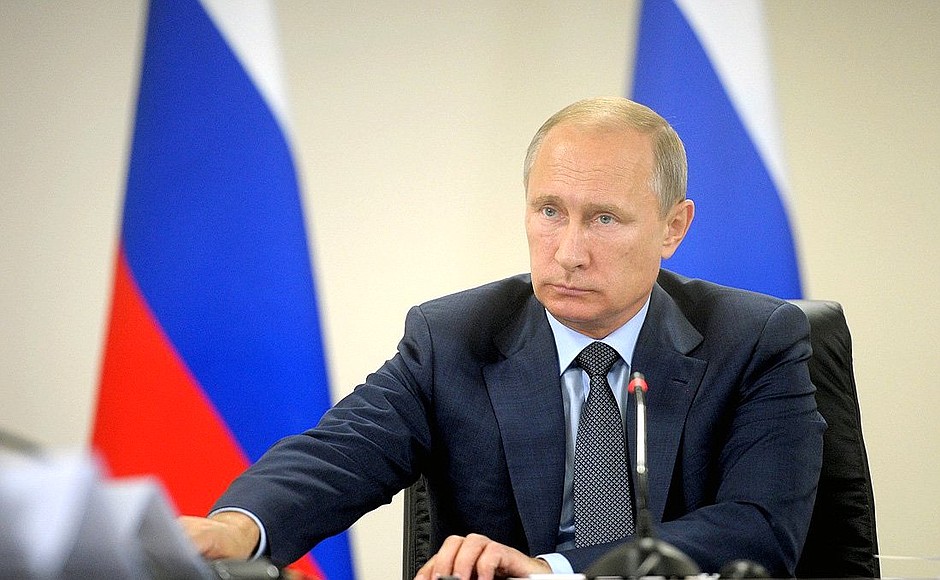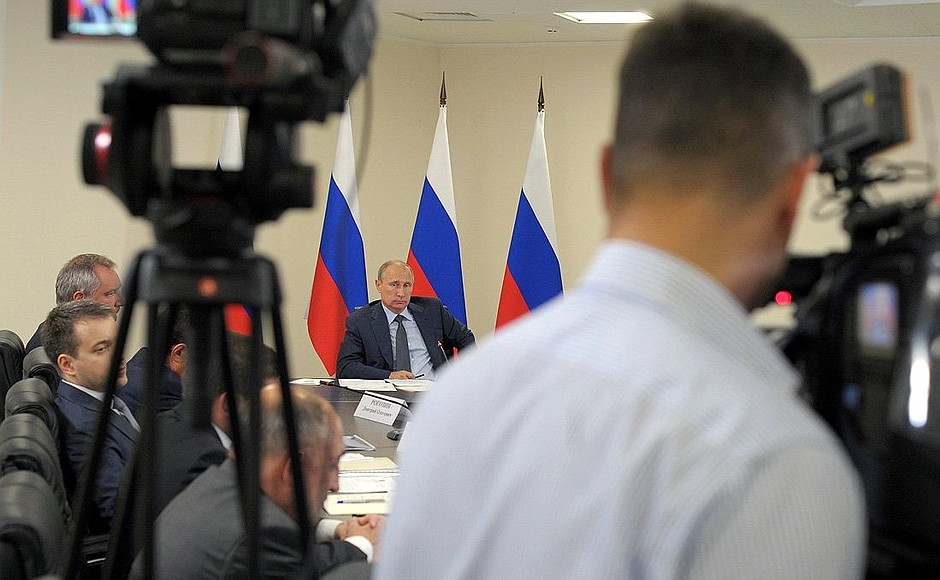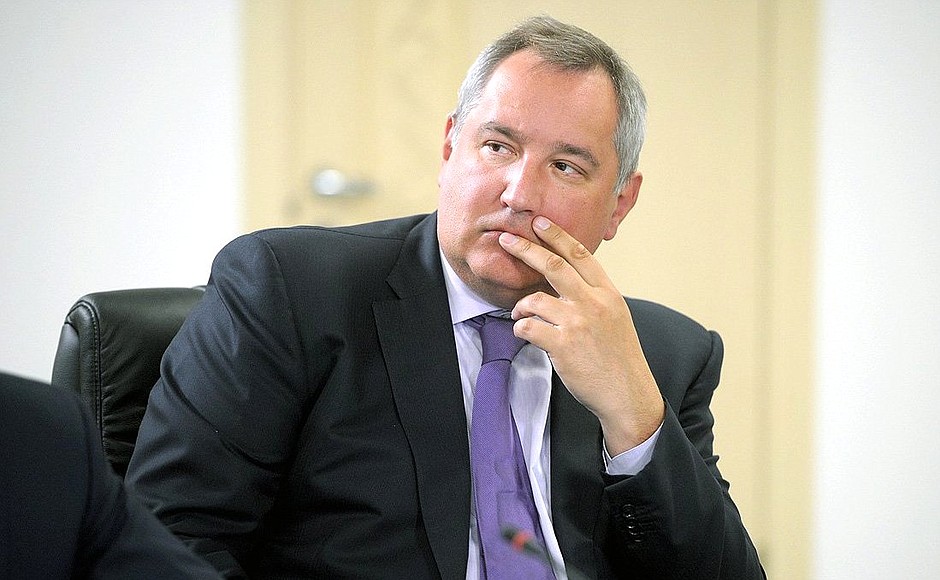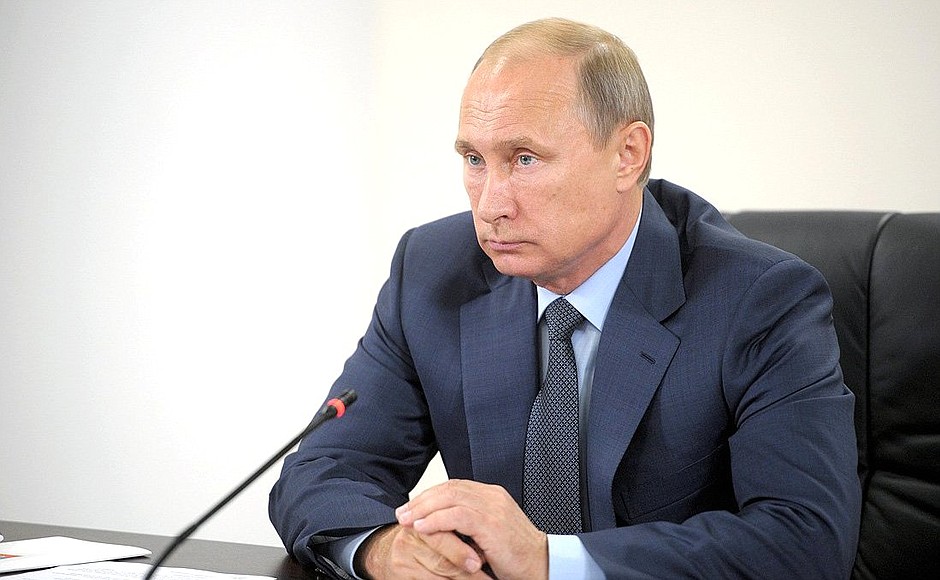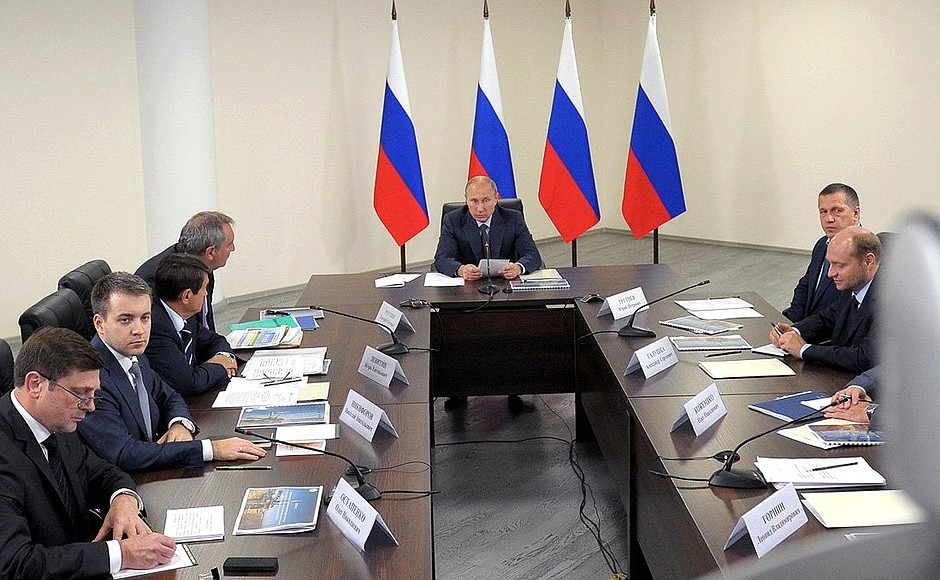See also
Prior to the meeting, the President visited the space centre construction site to observe the work.
* * *
Opening address at the meeting on the development of the Vostochny Space Launch Centre.
President of Russia Vladimir Putin: Good afternoon, colleagues.
Before we begin our discussion of the Vostochny Space Launch Centre’s construction, we will hold a videoconference with the participants in the construction of a new power substation – I can see them on the screen now. This facility is very important for the operation of the entire space launch centre.
I would like to thank everyone who took part in building the substation, and the entire Federal Grid Company of the Unified Energy System for the work they have done – and done well – on this very important component of the entire project.
Mr Murov, please.
chairman of the Federal Grid Company of the Unified Energy System andrei Murov: Thank you.
Mr President, colleagues, the FGC’s role in the construction of the Vostochny Space Launch Centre primarily has to do with the external energy supply of the facility itself and its infrastructure in Amur Region. Thus, in March 2014 we completed the first construction phase. This included the modernisation of the Ledyanaya power substation, where we are now. This made it possible to power the line between the Ledyanaya substation and the main step-down substation that is part of the space launch centre.
”Own space infrastructure, a modern network of space launch centres of various purpose would allow Russia to enhance its status as a leading space nation. It would guarantee our independent space activity and provide for the successful realisation of international programmes.“
Therefore, the space launch centre facilities that have already been built and the ones that are yet to be built have all been connected to the Far East power grid, in the final count being part of the unified power grid of the Russian Federation operated by the FGC.
Mr President, in the second phase we expect to add more external power supply; that is we will hook up to the line connected to our Amurskaya substation.
In the first stage, our capital investment amounted to about 600 million rubles. In the second stage, which should be completed in 2015, capital investment should make up about 640 million rubles [over $16 million]. The substation can provide about 121 megawatt.
Thus, at your order we can now start feeding this aerial line. I would like to note here that the Amurskaya substation, which will be hooked up to the step-down station during the second stage, is the most reliable segment of the Far Eastern power grid and an important element of the power bridge between Russia and China.
In conclusion, I would like to note that the FGC attaches great importance to the development of the power infrastructure in the Far East. We are involved in supplying electric power not only to Vostochny, but also to such important facilities as the Elginskoye coal field, the East Siberia-Pacific Ocean oil pipeline and, of course, the Baikal-Amur and Trans-Siberian railways. Overall, by 2019 the company envisages to invest some 85 billion rubles in energy facilities in the Far East and the Trans-Baikal area.
My report is over. Please allow our operating staff to proceed with switching the line on.
Vladimir Putin: Yes, begin please.
Andrei Murov: Mr President, I can report that the line has been powered and feeding our two substations: Ledyanaya and the step-down substation.
Vladimir Putin: Well done, congratulations. Thank you very much. I hope the plans you have just told us about will be brought to reality on time and thoroughly. Thank you.
”It is also important that with the creation of the Vostochny Space Launch Centre here in the Far East, we will create a powerful research and production centre. This, in turn, will bring in additional investment, help create new jobs to attract good young experts that the Far East needs so much.“
Now, colleagues, let us proceed with our agenda. Today we will consider the development of the land-based space infrastructure and analyse the progress in the construction of the Vostochny Space Launch Centre.
I would like to stress yet again that this is a major national project that will make it possible to launch spacecraft into outer space, to its farther reaches this time, and not depend on any launch sites outside the Russian Federation, although we will continue this line of work as well.
I would like to remind you that choosing this site was not easy; this was not the only location for the Vostochny Space Launch Centre that we considered: there was also one on the Pacific coast. Finally, the decision was made in favour of this place, bearing in mind the plans to develop the road and transportation infrastructure, its greater proximity to the equator and average annual data on the climate, temperatures and thousands of other parameters.
The state is investing heavily into this project, so it should have a multiplier effect. We intend to not only build this complex, but also to train staff locally and to create the infrastructure, both motorways and railways. We plan to extend the industrial capacity of Eastern Siberia, and Siberia in general, as well as the Far East. Overall, this can become a very good boost for the development of the entire Russian Far East.
Its own space infrastructure, a modern network of space launch centres of various purpose would allow Russia, as I have already said, to enhance its status as a leading space nation. It would guarantee our independent space activity and provide for the successful realisation of international programmes.
It is also important that with the creation of the Vostochny Space Launch Centre here in the Far East, we will create a powerful research and production centre. This, in turn, will bring in additional investment, help create new jobs to attract good young experts that the Far East needs so much.
”In 2015, Vostochny should be ready to launch automatic spacecraft using medium class Soyuz-2 booster rockets, and by 2018, it should take on the implementation of piloted flights. Later the space launch centre’s capacity will grow to launch heavy and super-heavy booster rockets, to implement programmes to study the Moon, Mars and other objects in outer space.“
Today we met with young people from the students’ construction teams who came from different parts of the Russian Federation. This is a place where they can be useful in the future. I mean, the team is made up of students majoring in aviation, space studies and the like.
You are aware of our ambitious plans for the development of this area. We discussed these plans just the other day in Yakutia. The new space launch centre should become one of the focal points of growth that we mentioned. As I have said, we are investing heavily from the budget into this project: over 100 billion rubles have been allocated since 2011, and another 50 billion should be allocated in 2015.
I would like to reiterate that all the deadlines for all the stages of the project must be met. With this in mind, we have to rule out any delays in funding. However, the funding should be carefully supervised to avoid any unreasonable overspending.
In 2015, Vostochny should be ready to launch automatic spacecraft using medium class Soyuz-2 booster rockets, and by 2018, it should take on the implementation of piloted flights.
Later the space launch centre’s capacity will grow to launch heavy and, as we mentioned earlier today, super-heavy booster rockets, to implement programmes to study the Moon, Mars and other objects in outer space.
Clearly, the construction work scope is colossal. We have to build the launch pads and technical facilities, about 1,500 various buildings and structures, and lay hundreds of kilometres of motorways and railroads.
At the same time, I would like to note that today we are 30 to 55 days behind schedule in the construction of the launch pad and the technical facilities. We have already mentioned this today, and we need to focus on it. We have just over 6,000 people working in shifts on this construction site, while we actually need 12,000 to 15,000, and the Head of Roscosmos has confirmed this.
In the course of this meeting, we will check the construction schedules and analyse the efficiency of their implementation. We have just seen the construction site. I would like to note that a lot has been done, but work on some facilities is behind schedule, as I have said. Therefore, first we need to find the reason for these delays and make sure the work proceeds in a more regular and coordinated fashion. I know Mr Rogozin [Deputy Prime Minister] can take care of this on a regular basis, since he comes here often, which is very good.
”The space launch centre should be developed alongside the creation of an up-to-date social infrastructure. We need to provide those who are building Vostochny and those who will be working here with comfortable housing, childcare facilities and schools.“
Further, I would like to stress that, as agreed, the space launch centre should be developed alongside the creation of an up-to-date social infrastructure – this is something else we will touch upon today – so that we do not leave it until later, as used to be the case in Soviet times, or never do it at all, or spend the money to build something else, knowing that later on we can get additional state funding. We need to provide those who are building Vostochny and those who will be working here with comfortable housing, childcare facilities and schools, and it has to be done on schedule. Our goal is to make sure that work at the space launch centre attracts new experts, especially young people.
I would like to hear a separate report on the social issues related to the project. We saw from the helicopter today that some residential blocks are already being built – about eight of them. But there should be 40: we need to house 12,000 people, while now the place can only take 3,500 at best.
Third, the development of the ground-based space infrastructure should be synchronised with the creation of new space equipment, primarily more reliable and safer booster rockets. This is a task for the United Rocket and Space Corporation.
Today we will also consider its establishment and any problems that may remain. At our previous meeting, some issues were raised and I would like to find out how we are moving along and at what pace.
Instructions were issued on July 21 in Samara to draft an executive order that would establish the corporation’s powers. I still have not seen this document. Let us see where the draft is now and when it will arrive on my desk.
In addition, I gave instructions to draft a financial recovery plan for a number of facilities belonging to the United Rocket and Space Corporation, and it has to be done within a timeline that would allow us to allocate funding within the 2015 budget – we are now finalising that budget. We will discuss this as well.
<…>

